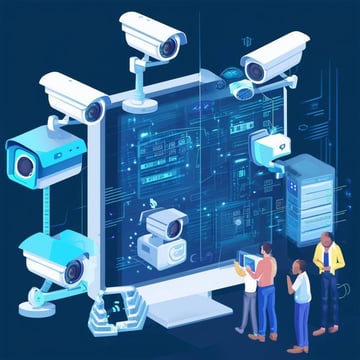- Product
Product Overview
Sophisticated security with unmatched simplicityCloud SIEM
Pre-configured detections across your environmentHoneypots
Deception technology to detect lateral movementEndpoint Visibility
Real-time monitoring with added detection & responseSecurity Reports
Data visualizations, compliance reports, and executive summariesAutomated Response
Detect, prioritize, and neutralize threats around the clockIntegrations
Cloud, on-prem, and open API connectionsXDR Platform
A complete view to identify risk, and things operational
- Pricing
- Why Blumira
Why Blumira
The Security Operations platform IT teams loveWatch A Demo
See Blumira in action and how it builds operational resilienceUse Cases
A unified security solution for every challengePricing
Unlimited data and predictable pricing structureCompany
Our human-centered approach to cybersecurityCompare Blumira
Find out how Blumira stacks up to similar security toolsIntegrations
Cloud, on-prem, and open API connectionsCustomer Stories
Learn how others like you found success with Blumira
- Solutions
- Partners
- Resources

If traditional IT security was like playing Pac-Man -- contained maze, predictable ghosts, clear boundaries -- today's hybrid environment is more like an open-world RPG. Threats can come from anywhere, your map keeps expanding, and there's no cheat code for keeping track of it all. For IT teams managing modern environments, maintaining comprehensive security visibility has become less like monitoring a simple game, and more like trying to track thousands of players across an ever-expanding virtual universe.
Today's Security Visibility Challenge
You likely don't just run a few on-premises servers and applications. Your digital environment spans cloud-based productivity tools, remote work infrastructure, authentication systems, and countless endpoints. Each system is its own potential entry point for threats, generating constant streams of logs and alerts that need monitoring.
Learn more about why event logs matter and how they help protect your organization. And, learn how unified visibility can help you monitor this expanding tech stack.
Like trying to defend a massive multiplayer game server - you need to watch player behavior, server performance, chat logs, and item transactions all at once. Except in this case, missing a suspicious event can have real consequences.
Why Visibility Is Breaking Down
Most organizations face three critical visibility challenges that make traditional approaches obsolete:
1. Scattered Data Sources
Security-relevant data is no longer centralized. Critical information is spread across:
- Cloud service audit logs
- Network device logs
- Authentication system logs
- Endpoint security alerts
It's like trying to piece together a player's actions by watching separate mini-maps - you might miss the bigger picture of what's really happening. Managing all these logs effectively requires a strategic approach.
Discover best practices for security log retention to ensure you're getting maximum value from your data.
2. Volume and Noise
The sheer amount of security data has exploded beyond human scale. Each system generates thousands of events daily, and finding real threats among routine activities has become nearly impossible through manual review.
Think about monitoring a game chat channel with millions of messages - how do you spot the few bad actors among all the normal conversations? That's the challenge IT teams face with security logs.
3. Limited Context
Individual security alerts often raise more questions than they answer. Without proper context, it's impossible to tell if a failed login is a forgotten password or an attack in progress, if unusual file access is legitimate or suspicious, or if a new network connection represents a threat. Tools like unified audit logs can help provide this crucial context.
Learn how to effectively search unified audit logs to investigate security events.
The Real Cost of Poor Visibility
According to IBM's 2023 Cost of a Data Breach report, organizations that take longer to identify and contain breaches face significantly higher costs. When you can't see what's happening across your environment:
- Threats can operate undetected for months
- Investigations become lengthy fishing expeditions
- Response times stretch from hours to weeks
- Damage spreads throughout your systems
Why Traditional Approaches Fall Short
Many organizations try to tackle visibility challenges through manual log review or multiple point solutions. This is like trying to monitor a modern open-world game using tools designed for Pac-Man - it simply doesn't scale.
Manual approaches quickly become overwhelming, point solutions create silos of information, and legacy security tools require expertise that most teams don't have. The game has evolved, but many teams only have limited tools or outdated strategies for protection.
What Modern Environments Need
Effective security visibility today requires a fundamentally different approach:
1. Comprehensive data collection that can scale with your environment
2. Intelligent analysis that separates threats from normal activity
3. Clear, actionable insights that guide response
4. Tools designed for resource-constrained teams
If you're wondering whether investing in better visibility is worth it for your organization, read why SMBs need to prioritize security.
Looking Ahead
Understanding these visibility challenges is the first step toward solving them. In our next piece, we'll explore how automated approaches are making comprehensive security visibility accessible even for small IT teams.
Contact us to learn more about achieving better security visibility for your organization.
Tag(s):
Security Trends and Info
More from the blog
View All Posts
SIEM XDR
4 min read
| November 25, 2024
What is Unified Visibility and What Does it Offer?
Read More
SIEM XDR
2 min read
| October 2, 2024
XDR Buyer's Guide
Read More
Security How-To
4 min read
| November 6, 2024
On Demand - I Log IT A Lot – Free Logging for Duo Security and Umbrella with Blumira
Read MoreSubscribe to email updates
Stay up-to-date on what's happening at this blog and get additional content about the benefits of subscribing.